Hi Everyone, The purpose of this page is to provide common information. If you are expecting or have an infant, please become extremely familiar with Tethered Oral Tissues. It is absolutely essential for you to become knowledgeable because the ‘trusted’ pediatric professionals are not generally up to speed on the topic.
Tethered Oral Tissues: Tongue Tie/Lip Tie/ Buccal (Cheek) Tie.
Tethered Oral Tissues (TOTS)
Video: Tethered Tissues and Breastfeeding
Video: Dr Richard Baxter, Author of Tongue Tied book, discusses Tongue and Lip Tie
Video: Amazing Results post release
Video: Post Frenectomy Stretches infant
Video: Post Frenectomy stretches, Dr Pinto
Video: Post Frenectomy Stretches, Dr Tran
Video: Long Term Implications of Untreated Tongue Tie, Dr Zaghi from The Breathe Institute
Video: Tongue Tie and the Fascia (soft tissue) Super interesting
Video: Suck Retraining for Tongue Tie
Video: Suck Retraining and Habilitation
Video: Tongue Exercises for Vagus Nerve Stimulation
Video: One of my birth-y friends, Mandy Irby, RN The Birth Nurse Tongue tie, craniosacral and chiro
Video: Tongue Tie and Torticollis
Article: Vagus Nerve, healing capacity
Article: Vagus Nerve and Digestion
Article: Everything you need to know about tongue tie
Article: Tongue Tie and Torticollis
What are TOTs? (https://kidtherapy.org/helpful-articles/tethered-oral-tissues-an-overview/)
Tethered Oral Tissues (TOTs) is a term used to describe tight, restrictive connective tissue between oral structures. This connective tissue is called frena. Everyone has frena but when this tissue is thick, tight, and restrictive of typical movement we say that that there is a “tie.” Lip ties, tongue ties and cheek ties fall under the TOTs umbrella. Identification of TOTs is important as these ties have the ability to negatively impact a child’s feeding skills, proper facial structure development, breathing, sleeping, and speech/language development.
Signs and Symptoms of TOTs
How can you tell if your child may have TOTs? Here are some signs and symptoms:
In babies (0-12 months):
difficulty latching to nipple (breast or bottle)
difficulty gaining weight/slow weight gain
losing milk/formula out of corners of mouth when eating
audible “clicking” sound while eating/sucking
difficulty holding a pacifier in mouth
congestion
reflux
open mouth posture
high, narrow hard palate
difficulty transitioning to solid foods
In toddlers and older children (12 months +):
history of symptoms reviewed above
drooling
messy eating
picking eating
snoring/sleep issues
delayed talking
speech that is difficult to understand
persistent speech sound errors
